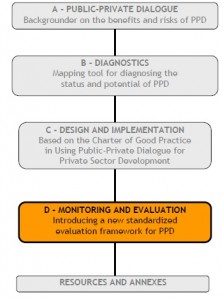D.1. Introduction
Monitoring and evaluation is closely related to planning. Monitoring is an ongoing activity that focuses on progress in terms of realization of activities and depletion of budget. Monitoring tracks mainly the use of inputs (activities) and outputs, but in some degree also tracks (intermediate) outcomes.
In contrast, evaluation takes place at specific moments, and …
D.2. Project management guidelines: three steps toward evaluating PPD
Setting up and conducting an evaluation framework for PPD can effectively follow a generic three-step
approach.19
D.2.1. Step One: Design of the M&E project brief
A project brief for the M&E exercise consists of the following elements:
(a) Background information about the PPD, and the context under which the M&E exercise takes place.
(b) Defining the basic questions that need to be addressed by the M&E framework, the main indicators
and how they can be verified;
(c) A description of the approach, methods and tools for the M&E framework. The following …
D.3. Methods and Instruments for data collection
D.3.1. Inventory and cataloguing of existing documentation
Usually, an inventory is a first step in data collection. It contains a first analysis of existing internal and external information on the PPD. Usually conducted by an external consultant, the inventory will lead to an inception report for the M&E process.
The analysis needs to be focused on the basic questions to be addressed in the M&E exercise defined in step one above. It offers an opportunity to identify and refine sub-questions and corresponding indicators, along with their sources of verification.
The …
D.4. Evaluation of organizational process and evolution of the PPD
This is the first of three sections presenting three different frameworks, tools, and sets of indicators to analyze PPD.
This section focuses on organization process and evolution. The following one looks mainly at the
impact of PPDs on political economy reforms relevant to private sector development. The next looks at more specific outcomes and impacts of a PPD on regulations and economic changes in the environment of the PPD. Ideally they should all be used in combination to obtain a complete overview of the overall results of PPDs.
D.4.1. Results matter, but so do processes: …
D.5. Evaluation of the political economy impact of PPDS on reform processes
This component of the evaluation exercise assesses the extent to which a PPD has been beneficial in starting up and implementing reforms identified as priorities by national governments.
D.5.1. Three elements of political economy reform
The political economy reform process depends on three related elements:
D.6. Evaluation of regulatory and economic outcomes and impact of PPDS
Regulatory and economic outputs, outcomes and impacts of PPDs can be evaluated based on the logical framework approach. As objectives, anticipated results and activities are likely to be different in each PPD, the approach presented here focuses upon providing the general logical framework model. The specific sets of indicators will need to be customized to each …
D.7. Concluding Remarks
D.7. CONCLUDING REMARKS
This section of the handbook has focused on providing general guidelines for setting up and planning an evaluation exercise for a PPD. Some methods and tools for data collection have been presented. Three frameworks, tools, and sets of indicators have been introduced, with the purpose of enabling comparison and benchmarking of …

